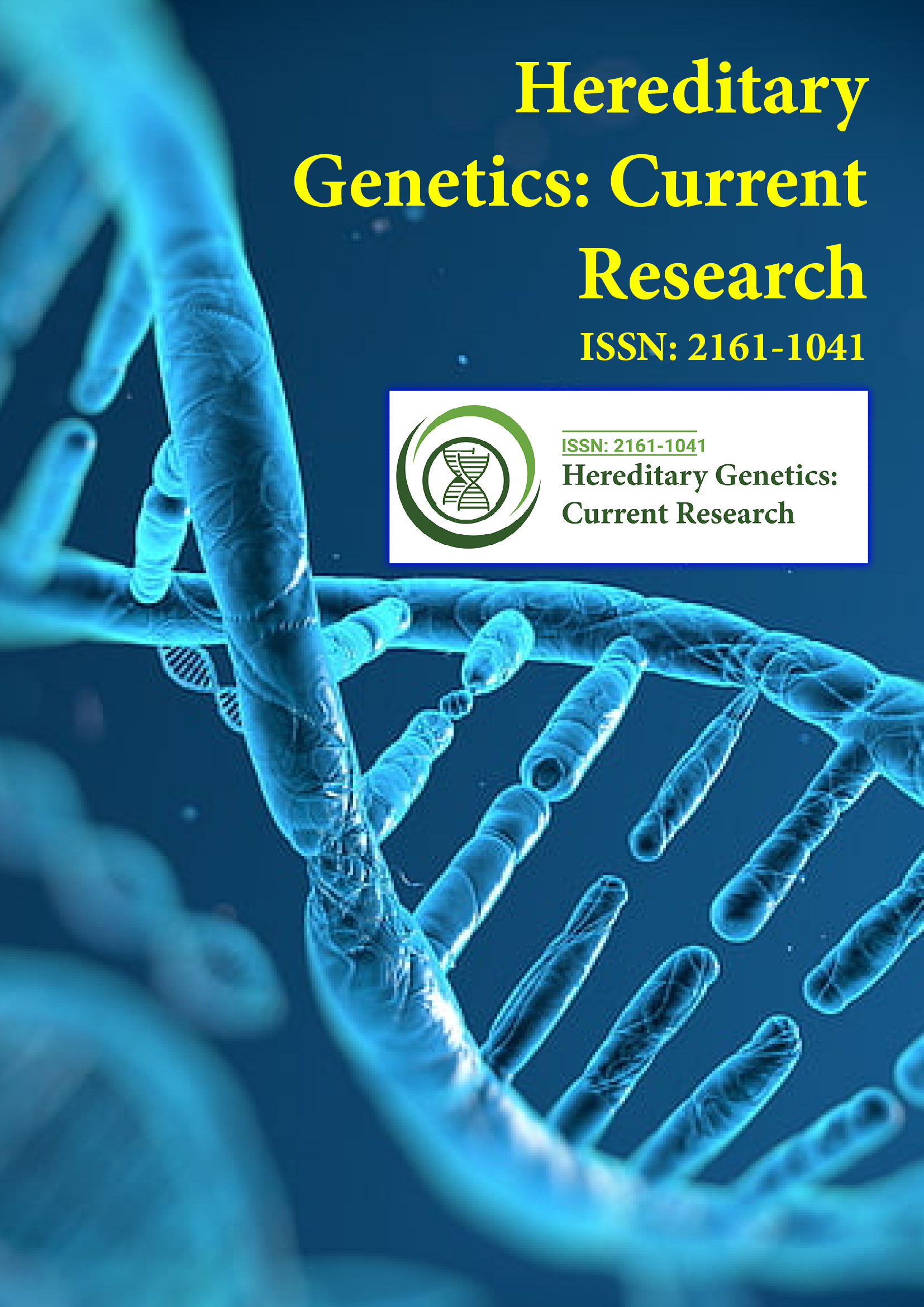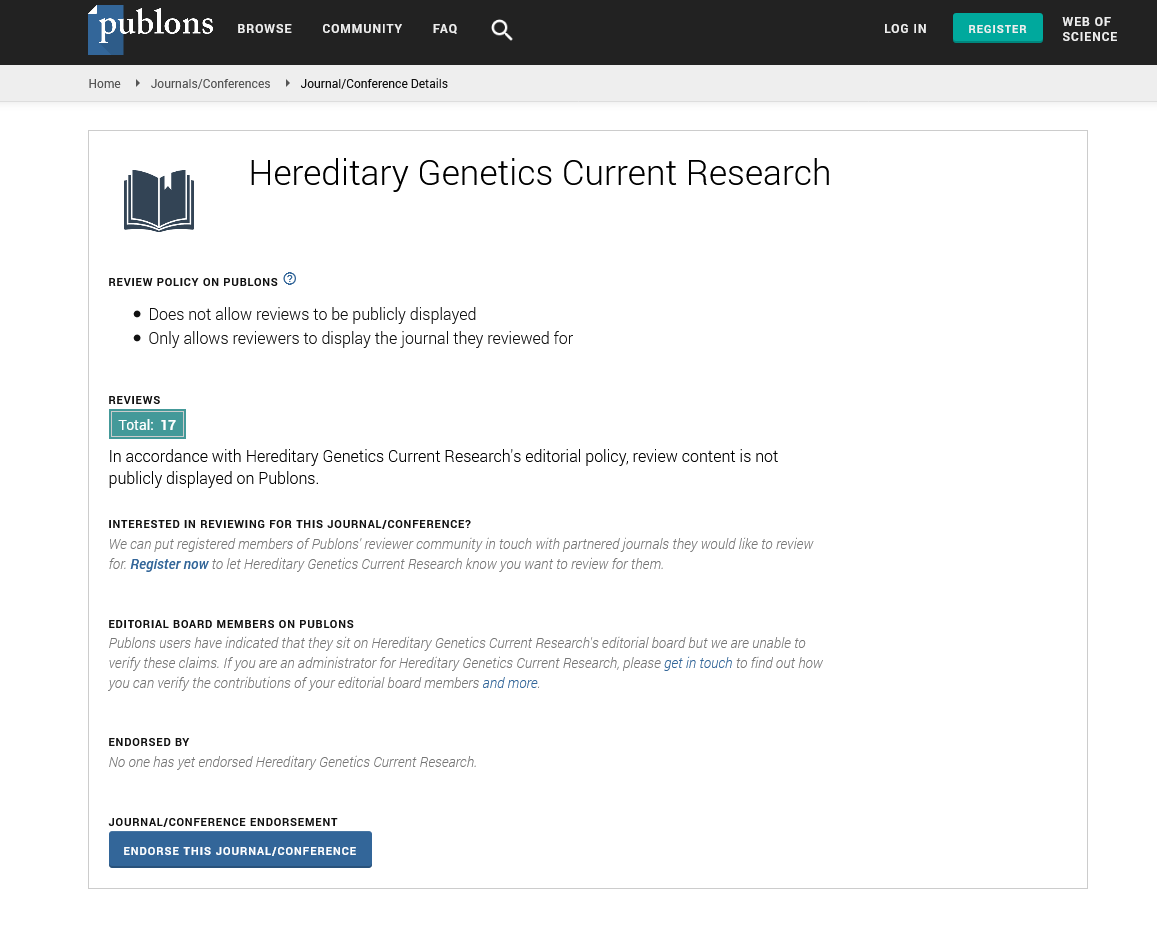Indexed In
- Open J Gate
- Genamics JournalSeek
- CiteFactor
- RefSeek
- Hamdard University
- EBSCO A-Z
- NSD - Norwegian Centre for Research Data
- OCLC- WorldCat
- Publons
- Geneva Foundation for Medical Education and Research
- Euro Pub
- Google Scholar
Useful Links
Share This Page
Journal Flyer

Open Access Journals
- Agri and Aquaculture
- Biochemistry
- Bioinformatics & Systems Biology
- Business & Management
- Chemistry
- Clinical Sciences
- Engineering
- Food & Nutrition
- General Science
- Genetics & Molecular Biology
- Immunology & Microbiology
- Medical Sciences
- Neuroscience & Psychology
- Nursing & Health Care
- Pharmaceutical Sciences
Perspective - (2023) Volume 12, Issue 1
Clinical Manifestations and Diagnosis of Muscular Dystrophy
Michael Brown*Received: 06-Mar-2023, Manuscript No. HGCR-23-19958; Editor assigned: 09-Mar-2023, Pre QC No. HGCR-23-19958 (PQ); Reviewed: 23-Mar-2023, QC No. HGCR-23-19958; Revised: 30-Mar-2023, Manuscript No. HGCR-23-19958 (R); Published: 06-Apr-2023, DOI: 10.35248/2161-1041.23.12.232
Description
Clinical manifestations
Muscular Dystrophy (MD) is a genetically and clinically diverse category of uncommon neuromuscular illnesses that cause progressive skeletal muscle loss and disintegration over time. The illnesses differ in terms of which muscles are most affected, the degree of weakness, how quickly symptoms progress, and when symptoms first appear. Some kinds are also linked to issues in other organs. Clinical indications might appear at any age, from infancy through childhood to maturity. Congenital muscular dystrophies typically manifest clinically at birth or within the first few months of life. Skeletal muscle weakness is a common observation, and the distribution of weakness can assist distinguish between different types of muscular dystrophy. Scoliosis is common in wheelchair-dependent children, especially during the pubertal growth spurt; it is also common in ambulant patients with specific forms of muscular dystrophy, such as Ullrich congenital muscular dystrophy or rigid spine congenital muscular dystrophy, but uncommon in other disorders that do not affect ambulation. The disease's progression is diverse and is mostly determined by the severity of the specific mutation affecting each gene. Most individuals with congenital muscular dystrophy variations never attain ambulation; ambulation is gained in childhood-onset forms but is usually lost in quickly progressive variants such as Duchenne muscular dystrophy or any of the limb girdle muscular dystrophies. Affected children in these kinds get increasingly weaker by the end of the first decade, and ambulation is lost by the early to middle adolescent years. In most cases of facioscapulohumeral muscular dystrophy and other limb girdle muscular dystrophies, ambulation may be maintained and wheel-chair assistance is required only later in life. Myotonic dystrophy clinical severity varies greatly, ranging from seriously afflicted neonates with catastrophic outcomes to moderately affected individuals with merely cataracts and grip myotonia. Respiratory impairment is common, although the onset, distribution, and course of respiratory muscle weakness can vary widely, and its severity is not always proportional to the degree of motor impairment. Respiratory insufficiency develops only after loss of ambulation due to widespread weakening of inspiratory and expiratory muscles in the majority of muscular dystrophy types where this consequence occurs. In some cases, ambulant individuals might develop respiratory insufficiency as a result of selective diaphragmatic weakening. Knowing these distinctions enables the adoption of disease-specific anticipatory respiratory treatment. Respiratory insufficiency usually begins at night, causing insomnia, morning tiredness and headaches, lack of appetite, and repeated chest infections.
These patients are especially vulnerable since they are frequently hypoxic, and unless their carbon dioxide levels are checked, they will generally be given supplemental oxygen, which can have serious repercussions because it suppresses the respiratory drive, leading to respiratory arrest. Cardiac involvement is frequent in many muscular dystrophies, however it is not always present. The age of start, progression, and kind of cardiac involvement vary. Although dilated cardiomyopathy is the primary presenting cardiac problem in Duchenne muscular dystrophy and other limb girdle muscular dystrophy variations, conduction deficits are a severe and invariable characteristic in others, such as Emery- Dreifuss muscular dystrophy. Functional or structural brain involvement occurs in several congenital muscular dystrophies and infrequently in limb girdle muscular dystrophy variations. Myotonic dystrophy and Duchenne muscular dystrophy are two of the greatest instances of functional involvement. A third of boys with Duchenne muscular dystrophy have non-progressive mental impairment and accompanying behavioural or psychiatric comorbidities (e.g., attention deficit disorder or autism). Structural brain problems have also been observed in advanced stages of Duchenne muscular dystrophy and myotonic dystrophy congenital muscular features. Diabetes and hypogonadism are also common in myotonic dystrophy.
Diagnosis
Although overlaps between genetically unique forms complicate the diagnostic pathway, the combination of clinical indications and an examination of the likely mode of transmission permits suspicion of particular forms of muscular dystrophy and the direction of subsequent investigations. Serum creatinine kinase levels are frequently more than 10 times higher than normal, however this does not indicate a particular illness. Normal creatinine kinase levels do not rule out some muscular dystrophies, such as Ullrich congenital muscular dystrophy or facioscapulohumeral muscular dystrophy. Electromyography may aid in the detection of myotonic discharges in myotonic dystrophy, however it is of little utility in the diagnosis of a particular condition in individuals with increased blood creatinine kinase. Muscle biopsy enables for morphological assessment and the elimination of illnesses with overlapping characteristics, such as myofibrillar myopathies. The use of a variety of antibodies to examine the amount and localization of various muscle proteins (appendix), as well as western blot analysis to quantify their abundance, may frequently aid in identifying the underlying main protein deficiency and directing genetic testing. However, because not all dystrophies have a protein deficiency signal, identifying the genetic abnormality is the gold-standard diagnostic technique. Muscle imaging to detect disease-specific patterns of muscle involvement 43-48 may be useful in the differential diagnosis of several neuromuscular disorders, according to growing evidence. A precise genetic diagnosis is required for accurate genetic counselling of afflicted individuals, as well as systematic referral to relevant counselling providers. The necessity of early diagnosis has been emphasized as evidence of the benefit of early intervention accumulates.
However, even for common varieties such as Duchenne muscular dystrophy, the average age of diagnosis is roughly 2 years following the onset of the early clinical indications. Although newborn screening programmes for Duchenne muscular dystrophy have been piloted, there is little agreement on whether these studies should be broadly used. Some of these programmes were cancelled because, in the absence of effective therapy, the benefits of screening appeared to be confined to a more informed decision for subsequent pregnancies.
Even in the absence of a definitive cure, neonatal screenings and early recognition of patients with Duchenne muscular dystrophy would allow recommendations for early aspects of care, such as physiotherapy, corticosteroids, and proactive treatments for psychosocial and behavioural issues, to be implemented.
Citation: Brown M (2023) Clinical Manifestations and Diagnosis of Muscular Dystrophy. Hereditary Genet. 12:232.
Copyright: ©2023 Brown M. This is an open-access article distributed under the terms of the Creative Commons Attribution License, which permits unrestricted use, distribution, and reproduction in any medium, provided the original author and source are credited.

